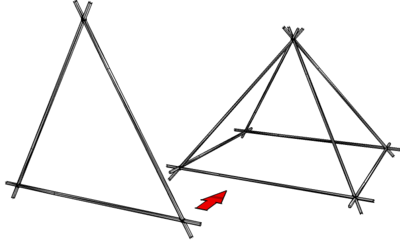Bamboo Structures
From DT Online
What to Make:
Build a structure as wide as your classroom, or as high, or both!
What to Use:
- Use only Pea Sticks or Split Bamboo garden canes each approximately 1 metre long (i.e. between 600mm and 1200mm)
- Use only elastic bands to make joints.
- Any filled in panels may be made by adding coloured tissue paper fixed in place using P.V.A. glue.
Things to find out and think about:
- Look at large framework structures (e.g. bridges, scaffolding, garage forecourt canopies) either by visiting them or searching for photos using the internet.
- Note the shapes made by the framework - how often do you see squares or triangles? Why do you think triangles are so common?
Some ideas:
Ways of Making:
- Lash together lengths of cane to make triangles using elastic bands - simply hook the elastic band round one end of a cane then keep it stretched tight as it is wrapped around the canes forming the joint.
- Link the triangles together to form pyramid like structures (e.g. either square or triangular).
- Join several pyramids together to create a large structure (e.g. a tower, a bridge across a classroom or a pyramid to walk inside).
Safety Point! Cane structures are very light in weight so a safe way to build a tall structure is to lift and add extra pyramids from underneath rather than trying to stand on desks and chairs etc.
Testing:
- Does it reach the classroom ceiling or allow you to walk under it or inside it?
- Which shapes worked best - triangles or squares?
Further Work:
Even larger models can be built similarly by binding together long lengths of card tube, plastics pipe or lengths of timber using cable ties, gaffer tape, duct tape or similar.


